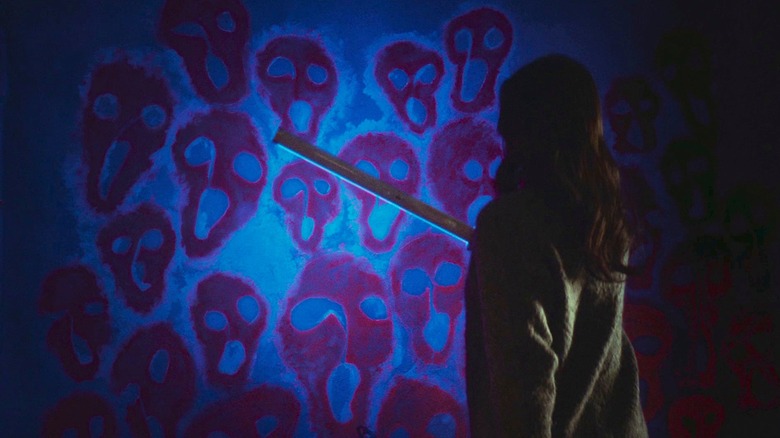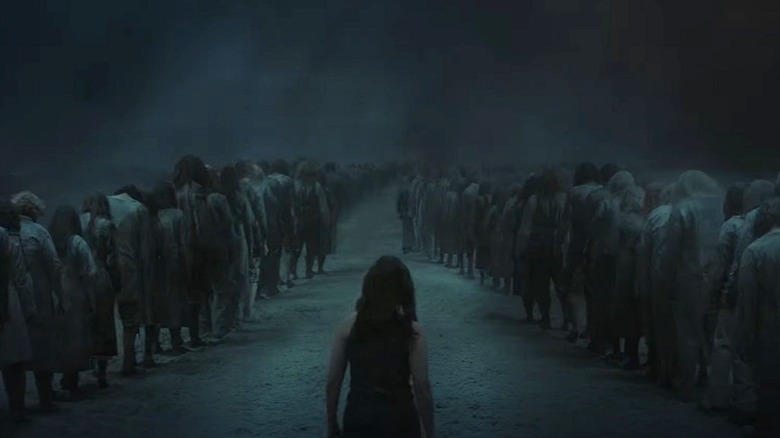The Cellar Was Originally Envisioned As A 'Full-Blown Monster Mash-Up' With No Adults [Spoiler Interview]
Warning: This article contains spoilers for "The Cellar." Proceed with caution.
"The Cellar" is a slow-burn horror movie. It's more about what's coming than what's happening. When the third act arrives in Brendan Muldowney's ("Pilgrimage") horror film, the story takes a sharp turn into the supernatural and features a rather impressive practical creature. Initially, however, things were meant to get a whole lot weirder for the film's central family that moves into the wrong house.
There were more creatures, for starters. Funny enough, the one creature that does arrive to shake things up? Crew members considered it a letdown on the set. During a recent interview with the filmmaker behind "The Cellar," both the original short film and now its feature-length film adaptation, Muldowney was candid about how he misses certain elements from the third act he first put on paper.
I had a draft that was so bonkers that no one can believe how bonkers it was
What were some of the more old-school horror movies on your mind while making "The Cellar?"
"The Amityville Horror," maybe "The Omen," and "The Haunting" are huge influences. There's a homage to "The Haunting" in there. No one's really noticed it yet, but it's quite a big one.
Which one is it?
It's when the mother is talking to her son in the cellar and then realizes he's not in there. There's "The Beyond." Well, in the trailer as well I see all the thumbnails, they've all chosen that "Beyond Shot."
The third act of this movie goes big, so how'd you want to tease those more supernatural elements? When did you decide the exact moment to go more wild?
The short film basically starts with the daughter babysitting and ends with her walking down the steps. It's a nice, neat time in a short film. Everything else here is an extension. I had a draft of this before. And when you say it goes surreal, I had a draft that was so bonkers that no one can believe how bonkers it was. It was a monster mashup that was like Hieronymus Bosch creatures walking around, crows and giant spiders. It was like "The Mist" nearly, it was a full-blown monster mash-up. It's too expensive. They didn't actually like it, either. It was way more of a sort of young adult version, even though this is for a broad audience. All the protagonists were kids. There were no real adults in it. So it would've been interesting to do, I have to say.
How much bigger and crazier did it get, exactly?
The third act, which was probably a little longer than the one we have here, was bigger. When you have monsters walking around, a lot of them, and you've got mist, heavy mist outside, it was probably more audacious. There were two reasons the producers, or at the time Conor [Barry], the producer I work with in my own company, said, "It's too expensive." It's what he said. Also, he wasn't digging the story. I think there could be millions of reasons for this. Sometimes having an older cast, it's easier to maybe get money because you can get a name actor. If you've got really young kids playing all the roles, it's unknown. So there might be very economical reasons why that didn't work.
Do you miss all those monsters, though?
Do I miss the monsters? Yeah. It's very hard to say that, because when you go on a journey with a film, that's one part of it. And then you move into the next stage and you fall in love with the next stage and you keep moving, and each part has its own heartaches and sacrifices and compromises, and yet triumphs. And as you get through it, every movie finds its own way. It changes, it evolves. You just have to love it like one of your kids at the end of the day.
Lucio Fulci's 'The Beyond,' that's exactly where the influence comes from
You still get one memorable creature and some practical surreal sights. Your production designer did really nice work with that "Beyond" set.
Well, you know what? Now, the production designer is superb, because not only did he do a great job, he built the whole set of the cellar and lots of other things and still gave money back at the end. Would you believe it? He was so good with money. We were so tight on budget. But that particular part, he would've been just responsible for what was on the ground. Everything else was green screen. So there's a whole collaborative thing there. You've got costume going, you've got makeup going, you've got hair, you've got the production design dealing with the ground, and then you've got the visual effects company that are dealing with this green screen background, basically. When I mentioned Lucio Fulci's "The Beyond," that's exactly where the influence comes from.
Going down the steps green screen, but then we jump into tunnels and stuff that is real again. And then we jump into a studio with a green screen, a different studio with all the extras. It's not as if I'm Mr. Green Screen — that's probably the most extensive green screen shoot I've ever done. I did deal with the same company who did the visual effects on my previous film, "Pilgrimage," but a lot of that wasn't green screen. It was wounds, fighting and slashing and heads being chopped off and stuff. It was very different because there's no green screen, it's a sort of different type of working with visual effects.
There's very little, if any, blood in this movie. How'd you land at that decision?
None at all, because the original short film, "The 10 Steps," was inspired by Robert Wise's "The Haunting." I mean, you could probably put "The Innocents" in there as well, but definitely "The Haunting." What I loved about it was the atmosphere: Not one piece of gore. I have a young daughter, a 10-year-old, and [they] can watch it. They may get scared, but they're not going to be scarred for life. So that was the inspiration, originally. There was no discussion about blood. The short film won the Citrus Fantastic Film Festival, which a hardcore genre audience. It also won the New York International Children's Film Festival. I don't know if that's still going now anymore, but we could see the broad range with the audience it was hitting. So that was always the goal with the film, is to make a sort of fun movie that the whole family can watch.
It's nice you have respect for scaring kids in movies. People don't give them enough credit as audience members.
Of course. Roald Dahl, the writer, never held back. My daughter's favorite film once was "The Others," the film with Nicole Kidman. She loved it.
I watched "The Haunting" and "The Innocents" back to back with my daughter. I asked, "What's your favorite or which is the scariest?" And she said "The Haunting's my favorite, but the scariest is 'The Innocents.'" That got under her skin more.
It's more Lovecraftian
How did Schrödinger's cat become a part of the story's mythology?
I was finding it difficult, "What sort of mythology will I hinge on this?" There's no mythology in the short, really. I had to build a whole mythology, and Schrödinger's cat just naturally came. Schrödinger did move to Ireland and he did work on string theory. I would say I cut four minutes of discussions about dimensions. There was a möbius strip to explain the ant on the wires, which isn't correct. I loved the möbius strip because the infinity, when you twist a paper, it was nearly like heralding what happens at the end, but it all had to come out because, as you do when you edit a film, things just start to get too long and the pace flags. So it just came out.
Going back to the third act, how'd the main creature's design evolve?
The original short film, it was more the devil. This time round, it's more Lovecraftian. It's the void is what I call it — not hell, it's the void, the creatures. And that's why there were more monsters. The creature is really a gatekeeper or a soldier to this sort of world. The creation of it, I went through a lot of Pinterest images and there was a brilliant one. And to this day, I'm sad I didn't contact the person who designed it. It was a game designer, and it was a very interesting hairless one. But it was the same as any other creature design, except that we had far less money. I think it was the same company, if I'm correct, or the same people anyway, who had designed that robot for the film, "I Am Mother."
I think that it cost a million or something to make that robot. I mean, we had 20,000 Euro or something like that, or 30,000. It was hard. You have to make compromises. There's no animatronics. "Which parts are going to be seen? Okay. Don't work on the fur on that part." The whole film was written around a closeup of a hoof that was going to come in. When we filmed it and we cut it in, people thought it let the film down. It was like a pony. So in a way, it had to come out and you may know there's a scene where she's under the table and a shadow is approaching. So it's now a shadow, not a hoof.
Did you always have the bleak ending in mind?
I was always wondering how to extend this film. The short film ends with the steps and the counting and I was going, "Okay, how do you top that?" And it was always like, "Okay, you got to pull it off again." And in a way, I don't know if I did, when I say pull it off again, it's like how the mother suddenly realized what happened. I was saying, "That's not enough." I was trying to think how I'd end it, and I was looking at Escher paintings or drawings one day.
I was looking at it and I just went, "Oh, yeah. Eureka." Once I had that, I was able to work backwards from it. And that was a natural sort of dark ending. The short film ended like that as well. I don't know, I know there is a thing whether it's upbeat endings or downbeat, but that was naturally how this film felt like it should end.
"The Cellar" is now in limited theatrical release and is available to stream on Shudder.



